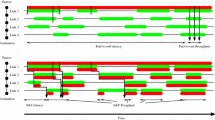Abstract
Low-orbit satellites have the advantages of low latency, low cost, and flexible launching. They are the main direction for the development of next-generation satellite communications. Based on the STK analysis and simulation of the existing low-orbit satellite constellations, this article found that most of the current polar orbiting constellations can be seen at the same time near the equator, and the inclined orbits cannot cover the earth’s poles. Therefore, a constellation with a polar orbit and an inclined orbit is designed to achieve global coverage under the conditions of reasonable number and cost of satellites and more optimized coverage performance. Lay the foundation for the network design of the future LEO satellite constellation.
Access this chapter
Tax calculation will be finalised at checkout
Purchases are for personal use only
Similar content being viewed by others
References
Zhu, L., Wu, T., Zhuo, Y.: Introduction to Satellite Communication. Electronics Industry Press, Beijing (2015)
Li, Y.: Research on satellite-earth integrated Link16 low-orbit satellite data link. Radio Eng. 6, 24–26 (2017)
Wei, X.: The deployment of the “Iridium” satellite constellation is complete. Int. Space 8, 10–11 (1998)
Hou, X., Yan, J., Zhao, J.: Analysis and prospect of key technologies of satellite mobile communication system. Digit. Commun. World 07, 52–54 (2011)
Li, B.: Analysis of SpaceX’s launch of large-scale test satellite deployment. Int. Space 6, 12–16 (2019)
Wang, M., Lu, Y.: STK and its application in satellite network simulation demonstration. China Radio 5, 33–34 (2019)
Qin, D., Chen, X.: STK and its application in satellite network simulation demonstration. J. Acad. Command Technol. 4, 66–69 (2001)
Ding, S., Zhang, B.: The Application of STK in Space Mission Simulation Analysis. National Defense Industry Press, Beijing (2011)
Hui, H., Zhou, C., Xu, S., Lin, F.: A novel secure data transmission scheme in industrial internet of things. China Commun. 17, 73–88 (2020)
Zhang, D.: Beidou navigation satellite orbit simulation based on STK software. Eng. Survey. Mapp. 7, 14-18+23 (2015)
Gong, C., Lin, F., Gong, X., Lu, Y.: Intelligent cooperative edge computing in internet of things. IEEE Internet Things J. 7, 9372–9382 (2020)
Yang, B., Zhang, S., Fang, S.: Research and simulation analysis of satellite coverage model based on STK. Ship Electron. Warfare 1, 66–71 (2016)
Hu, C., Wang, H., Hu, L.: STK software satellite visibility and coverage analysis. Global Position Syst. 4, 43–46 (2007)
Li, W., Baoyintu, Jia, B., Wang, J., Watanabe, T.: An energy based dynamic AODV routing protocol in wireless ad hoc networks. Comput. Mater. Continua (CMC) 63, 353–368 (2020)
Ke, Z., Yan, B.: Visibility simulation analysis of a new generation of Beidou navigation satellite based on STK. Electron. Des. Eng. 25(15), 153–157 (2017)
del Portillo, I., Cameron, B.G., Shuaijun, L.: Technical comparison of the three global broadband low-orbit satellite constellation systems Telesat, One Web and Space X. Satell. Netw. 07, 48–61 (2019)
Xiao, N., Liang, J., Zhang, J.: Design and planning of China’s low-orbit satellite constellation network. Telecommun. Technol. 50, 14–18 (2010)
Wei, Z., Wang, Q., Yao, J.: Design and optimization of low-orbit satellite inclined orbit. Shanghai Aerosp. 27, 26–29 (2010)
Acknowledgement
We gratefully acknowledge anonymous reviewers who read drafts and made many helpful suggestions.
Funding
This work is supported by Higher Education Department of the Ministry of Education Industry-university Cooperative Education Project.
Author information
Authors and Affiliations
Editor information
Editors and Affiliations
Ethics declarations
The authors declare that they have no conflicts of interest to report regarding the present study.
Rights and permissions
Copyright information
© 2021 Springer Nature Switzerland AG
About this paper
Cite this paper
Zhang, T., Chen, F., Sun, Y., Guo, C. (2021). A Resource-Saving Multi-layer Fault-Tolerant Low Orbit Satellite Network. In: Sun, X., Zhang, X., Xia, Z., Bertino, E. (eds) Artificial Intelligence and Security. ICAIS 2021. Lecture Notes in Computer Science(), vol 12736. Springer, Cham. https://doi.org/10.1007/978-3-030-78609-0_59
Download citation
DOI: https://doi.org/10.1007/978-3-030-78609-0_59
Published:
Publisher Name: Springer, Cham
Print ISBN: 978-3-030-78608-3
Online ISBN: 978-3-030-78609-0
eBook Packages: Computer ScienceComputer Science (R0)




